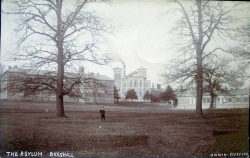St. Marys Hospital, Burghill
| St. Marys Hospital, Burghill | |
|---|---|
 | |
| Established | 1868 |
| Opened | 1871 |
| Closed | 1994 |
| Current Status | Demolished (Mostly) |
| Building Style | Corridor Plan |
| Architect(s) | Robert Griffiths |
| Location | Burghill, Herefordshire |
| Alternate Names |
|
History[edit]
Herefordshire initially utilized subscription asylum premises within the Hereford General Infirmary site and following the 1845 act entered into agreement with the Welsh counties of Monmouthshire, Radnorshire and Breconshire to construct the Joint counties premises at Abergavenny. Breakdown of the union led to Herefordshire providing its own asylum located close to the County Town of Hereford, who funded a proportion of the development. The rural nature of Herefordshire prevented further need for accommodation. The asylum became known as St. Mary's Hospital named after the local parish church.
The new establishment in Burghill, which replaced the original Asylum in Hereford, covered 10 acres and cost £87,873.00 to build. It was completed in 1871. There were a further 100 acres of gardens, a farm and several cottages. The main asylum was divided into a block for men and one for women, each wing constructed to house 200 patients. The male block contained a workshop and brewhouse, the female block a laundry. In addition to a dining and recreation hall, there was a chapel. A gasworks in the grounds supplied the gas for lighting the building. The hospital staff included both male and female attendants, a housekeeper, cook, laundress, housemaid, kitchen maid, porter, baker, engineer and stoker. A bailiff managed the house and grounds: there was also a gardener, cowman, wagoner and some farm workers. In 1872 the rector of Credenhill was chaplain. Part of his remit was to organize entertainment for the patients, including dances, walks, and concerts. Male attendants were paid more than double the salary of the female attendants.
At the beginning of the 20th century, the asylum was enlarged due to overcrowding and verandahs were added for patients with tuberculosis. The name was changed to St. Mary's Hospital. A small isolation hospital was built in the grounds in 1911. In 1994 the hospital was closed. When most of the mental hospital was demolished to make way for a housing estate, it was first thought that the charming Italianate chapel towers might be saved. However, it soon became apparent that the towers were unsafe and had to be demolished along with rest of the building.
On August 18, 1944, a B-24H Liberator Bomber was engaged on a leaflet dropping training mission. Seen trailing smoke from below the level of Credenhill Hill, one of its wings hit a chimney stack at the Mental Hospital and crashed in flames into the grounds.The chimney collapsed through the roof of the hospital into a ward, and whilst none of the patients was injured, all 10 of the American air crewmen were killed. The cause of the crash was probably engine failure. In 2011 a memorial plaque to the illfated air crew was unveiled in the churchyard above the Twelve Apostles: yew trees which were planted in 1964 to replace the ones which lined the path to the main porch in Wordsworth’s day.
